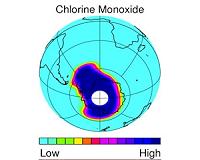| . |  |
. |
Reston VA (SPX) Jun 03, 2010 The eruption of the volcano in Iceland has drawn attention to air flow patterns, as airlines lost millions of dollars and travelers remained stranded for days to weeks, as particles from the natural disaster traveled over Europe, forcing closures of major airports. The flow of particles, although seemingly random, can be characterized more effectively, according to work done by Virginia Tech's Shane Ross of the engineering science and mechanics (ESM) department and his colleague Francois Lekien of Ecole Polytechnique, Universite Libre de Bruxelles, Belgium, who reported their findings in the publication Chaos. http://chaos.aip.org/chaoeh/v20/i1 Their research "will aid scientists and engineers in understanding and in controlling this type of global-scale phenomena, such as pollution dispersion in the atmosphere and the ocean, and large-scale transport of biological organisms, including airborne plant pathogens and respiratory disease agents," said Ishwar Puri, head of the ESM department at Virginia Tech. For example, the current British Petroleum oil spill in the Gulf of Mexico, might be modeled using Ross and Lekien's findings to provide greater insight into how the particles might be dragged into the Gulf of Mexico's Loop Current. In explaining how they conducted their research on the flow of particles, Ross and Lekien said they employed existing scientific principles of Lagrangian coherent structures, which reveals the separation of the atmosphere into dynamically distinct regions, to investigate the shapes of geophysical flow patterns. They used the 2002 discovery of the Antarctic Hole in their work because they viewed it as a "prototype atmospheric event" allowing for their studies on topological divisions on the mixing and transport of atmospheric tracers. As the media worldwide broadly publicized the finding of the Antarctic hole, it became the focus of the atmospheric science community. As Ross described the event, when the ozone hole split in two, allowing one of its fragments or regions to reassert its position over the Antarctic Pole while the other one spread into the mid-latitude regions, it implied "a sudden stratospheric warming." This type of global warming occurs in roughly half of all winters in the Arctic. The scientific explanation, Ross said, is "they are produced by the dynamic momentum force resulting from the breaking and dissipation of planetary-scale Rossby waves in the stratosphere." This phenomenon had never been observed in the Antarctic prior to 2002, according to reliable records that go back some 50 years. Consequently, Ross and Lekien labeled it a "prototype" of rare atmospheric events. Reviewing data from the event, they were able to determine that an isolated "blob of air" was slowly rotating over Antarctica. Lagrangian coherent structures, some which repel nearby air and some that attract it, formed inside the vortex. The vortex pinched off, sending the northwestern part of the ozone hole off into the mid latitude range while the southwestern portion returned to its regular position over the South Pole. Consequently, they write, when there is more than one vortex flow on a sphere, such as the planet Earth, "complicated spatial structures can arise and evolve, such as the polar vortex split." They were able to model this event, capturing some of its dynamic features. "This model is very relevant both in atmospheric and oceanographic settings when one considers large-scale phenomena where the spatial geometry of the Earth's surface becomes important. The full spherical geometry, as opposed to tangent plane approximations, is particularly important when considering global streamline patterns generated by a given vorticity distribution...These patterns, in turn, provide the dynamical templates by which one can begin to understand the chaotic advection of particles in a vortex-dominated flow."
Share This Article With Planet Earth
Related Links Virginia Tech All about the Ozone Layer
 NASA Study Sheds Light On Ozone Hole Chemistry
NASA Study Sheds Light On Ozone Hole ChemistryPasadena CA (SPX) Apr 29, 2010 A new NASA study of Earth's polar ozone layer reinforces scientists' understanding of how human-produced chlorine chemicals involved in the destruction of ozone interact with each other. A team of scientists led by Michelle Santee of NASA's Jet Propulsion Laboratory, Pasadena, Calif., examined how nighttime temperatures affect chlorine monoxide, a key chemical involved in ozone destruction ... read more |
|
| The content herein, unless otherwise known to be public domain, are Copyright 1995-2010 - SpaceDaily. AFP and UPI Wire Stories are copyright Agence France-Presse and United Press International. ESA Portal Reports are copyright European Space Agency. All NASA sourced material is public domain. Additional copyrights may apply in whole or part to other bona fide parties. Advertising does not imply endorsement,agreement or approval of any opinions, statements or information provided by SpaceDaily on any Web page published or hosted by SpaceDaily. Privacy Statement |